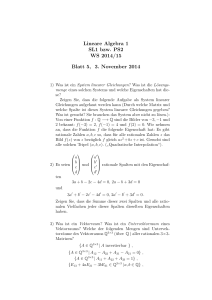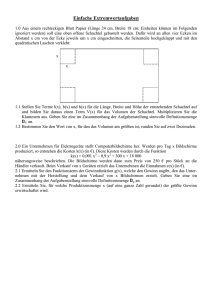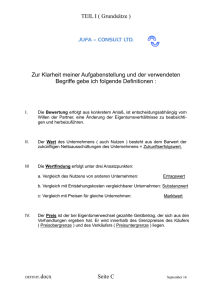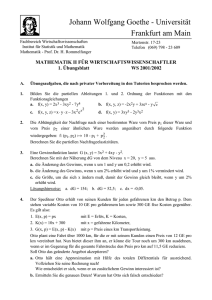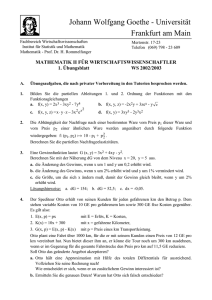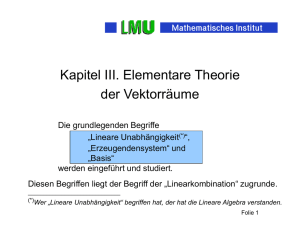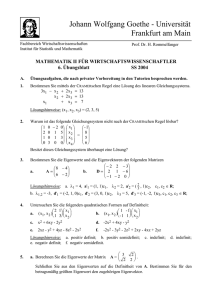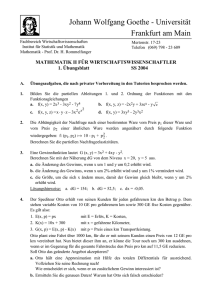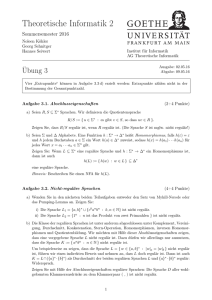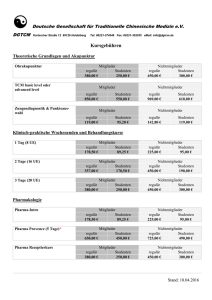Document
Werbung
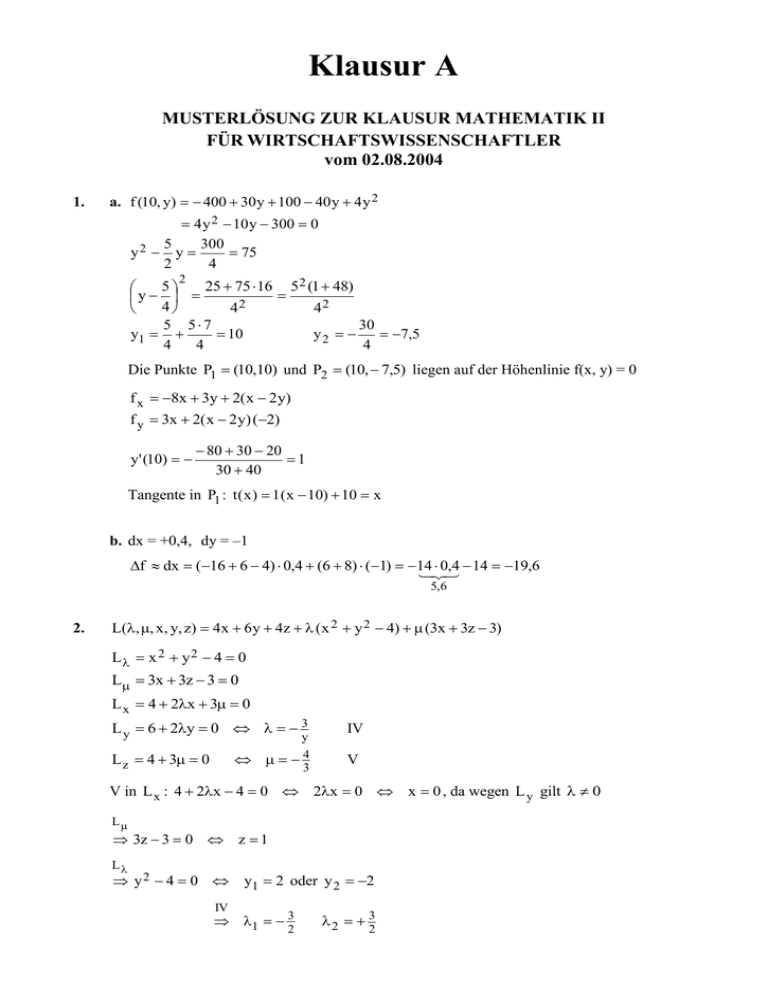
Klausur A MUSTERLÖSUNG ZUR KLAUSUR MATHEMATIK II FÜR WIRTSCHAFTSWISSENSCHAFTLER vom 02.08.2004 1. a. f (10, y) 400 30 y 100 40 y 4 y 2 4 y 2 10 y 300 0 5 300 y2 y 75 2 4 2 5 25 75 16 5 2 (1 48) y 4 42 42 5 57 30 y1 10 y2 7,5 4 4 4 Die Punkte P1 (10,10) und P2 (10, 7,5) liegen auf der Höhenlinie f(x, y) = 0 f x 8x 3y 2( x 2 y) f y 3x 2( x 2 y) (2) y' (10) 80 30 20 1 30 40 Tangente in P1 : t ( x ) 1( x 10) 10 x b. dx = +0,4, dy = –1 f dx (16 6 4) 0,4 (6 8) (1) 14 0 ,4 14 19,6 5,6 2. L(, , x, y, z) 4x 6 y 4z ( x 2 y 2 4) (3x 3z 3) L x 2 y 2 4 0 L 3x 3z 3 0 L x 4 2x 3 0 L y 6 2y 0 3 IV L z 4 3 0 V y 4 3 V in L x : 4 2x 4 0 2x 0 x 0 , da wegen L y gilt 0 L 3z 3 0 z 1 L y 2 4 0 y1 2 oder y 2 2 IV 1 3 2 2 3 2 2 Zwei stationäre Stellen P1 ( 3 , 4 , 0, 2,1) und P2 ( 3 , 4 , 0, 2,1) 2 3 2 3 0 0 L ( , , x , y, z ) 2 x 2y 0 0 2x 2 y 0 3 0 3 2 0 0 0 2 3 0 0 0 3 0 0 0 Es liegt Fall C vor! 0 0 3 4 Da L ( , , 0, 2,1) 0 2 3 4 0 0 0 0 3 3 3 0 0 3 0 4 0 0 3 0 3 3(1) 4 2 0 3 0 3(1) 2 5 0 0 0 0 4 0 0 0 3 3 0 0 3 0 4 0 3 0 0 0 4 0 3 0 9 [3 4 4] 0 4 0 3 d. h. f hat u. B. d. Nb. in P1 ein relatives Maximum. 3. Px x 2 4y 17 Py 4x 5y 3z 25 in (7, 8, 1) in (5, 2, 5) – 49 + 32 + 17 = 0 –25 + 8 +17 = 0 28 – 40 + 3 – 25 = 34 0 20 – 10 + 15 – 25 = 0 Pz 3y 3(z 2) 2 21 6 – 27 +21 = 0 P hat in (7, 8, 1) keine stationäre Stelle und als nach allen Variablen partiell differenzierbare Funktion dort kein relatives Extremum. P hat in (5, 2, 5) eine stationäre Stelle. P( x, y, z) 2x 4 0 4 5 3 0 3 6(z 2) 10 4 0 Da P (5, 2, 5) 4 5 3 50 18 90 18 4 2 18 (50 5 16) 0 0 3 18 10 4 50 4 2 0 , 4 5 H1 10 0 ist P(5, 2. 5) negativ definit. P hat in (5, 2, 5) ein relatives Maximum. Damit hat der Physiotherapeut Recht. 3 4. a. X B 3X XA F A' B X (B 3E A) F A' B X (F A' B) (B 3E A) 1 2 2 1 0 0 1 1 1 BEA 3 0 1 0 1 1 2 1 4 6 3 0 1 2 2 6 4 F A' B 0 1 0 3 2 1 12 0 1 2 4 –1 1 1 0 1 –4 0 1 1 –1 –1 0 0 –3 1 1 1 0 4 1 0 1 X 5. 1 3 3 1 3 3 1 3 4 1 1 3 1 1 10 28 6 4 4 1 28 10 3 3 1 3 3 3 1 0 3 1 1 1 VI. v x 5 0 VII. w y 6 0 x v5 y w6 z 4 ( v 5) 3( w 6) 4v 3w 20 18 4v 3w 38 z 4v 3w 38 I. ( v 5) 3( w 6) 42 v 3w 42 5 18 19 v 3w x1 19 II. 3( v 5) ( w 6) 10 3v w 10 15 6 11 ist immer erfüllt für v, w 0 III. ( v 5) 7( w 6) 28 v 7w 28 5 42 19 ist immer erfüllt für v, w 0 IV. 2( v 5) ( w 6) 30 2v w 30 10 6 14 2v w x 2 14 4 ( v 5) ( w 6) 18 V. v w 18 5 6 7 v w x3 7 z v w x1 x2 x3 RS 1 x1 x2 –4 –3 0 0 0 38 1 2 3 1 1 0 0 1 0 0 19 14 x3 1 1 0 0 1 7 Als Pivotelement kommt a 21 2 oder a 31 1 in Betracht. 6. 7 0 0 x a. Q ( x, y, z) ( x, y, z) 0 1 2 y 0 2 5 z 7 0 0 0 1 2 (7 ) (1 ) (5 ) 4 (7 ) 0 2 5 (7 )[5 6 2 4] 0 1 7 0 2 6 1 0 ( 3) 2 9 1 8 2 3 8 0 3 3 8 0 Q(x, y, z) ist positiv definit. x1 x2 x3 RS 0 0 0 0 0 –6 –2 0 0 –2 –2 0 0 –4 0 0 0 1 1 0 0 1 0 0 0 0 1 0 0 2 1 6 1 3 b. B 7 0 5 2 4.Spalte 0 1 1 3 4 (1)1 4 0 5 1 x 0 t1 0 t1 R Das LP-System ist in Phase 2. 1 v Min 19 , 14 , 7 7 2 1 5 7 (6) (1) 2 1 2 1 3 5 2 0 1 1 5 42 [20 15 (6 25)] 42 [5 31] 42 26 1.092 Da B 0 , hat B den Rang 5. 7. a. Der direkte Bedarf an Einzelteilen pro Halbfertigware wird beschrieben durch die Matrix 4 3 EH 1 0 2 5 3 0 0 2 . 6 4 Der direkte Bedarf an Einzelteilen pro Uhr wird beschrieben durch die Matrix 2 1 EU 0 0 0 1 3 0 1 0 . 2 7 Der direkte Bedarf an Halbfertigwaren pro Uhr wird beschrieben durch die Matrix 2 1 2 H U 2 4 5 1 1 1 b. Der Gesamtbedarf an Einzelteilen pro Uhr setzt sich zusammen aus dem direkten und indirekten Bedarf: B EU EH H U 2 1 B 0 0 0 1 3 0 1 12 0 18 2 14 7 4 12 25 19 4 18 14 33 19 23 14 4 4 12 26 22 4 19 33 25 11 c. Zur Herstellung des Produktionsprogramms x' = (100, 300, 200) werden benötigt 8. - an Halbfertigmodulen 2 1 2 100 900 H1 H U x 2 4 5 300 2.400 H 2 1 1 1 200 600 H3 - an Einzelteilen 14 19 Bx 14 4 12 26 22 4 19 8.800 E1 100 33 16.300 E 2 300 25 13.000 E3 200 11 3.800 E 4 a. d lässt sich als Linearkombination von a, b, c darstellen, wenn ax1 bx 2 cx 3 d eine Lösung hat. 6 b. P ist regulär, wenn die Vektoren a, c, d linear unabhängig sind, d. h. wenn ay1 cy 2 dy 3 0 nur die triviale Lösung besitzt. c. Q x q ist nicht für jedes q R 3 lösbar, wenn das Gleichungssystem az1 bz 2 dz 3 eine nicht triviale Lösung aufweist. a 3 0 0 3 0 0 1 0 0 1 0 0 b 1 6–s 4 –3 4–s 1 –1 4–s 1 0 0 1 c 4 2 4 0 0 1 0 0 1 1 s–4 1 d 4 + 3t 4+t 4 3t 2+t 1 t 2+t 1 t+1 t+s–2 1 zu a. d lässt sich auf eindeutigem Weg als Linearkombination von a, b, c darstellen, wenn: 4s 0 s 4 t kann dann eine beliebige reelle Zahl sein. Ist s = 4, dann lässt sich d nur dann als Linearkombination von a, b, c darstellen, wenn: 2 t 0 t 2 zu b. P ist regulär, wenn 2 t 0 t 2 . zu c. Q x q ist nicht für jedes a R 3 lösbar, wenn t s 2 0 . 9. wahr Sind alle Elemente auf der Hauptdiagonalen von A negativ, dann ist die quadratische Form Q(x) = xAx negativ definit. Eine mn-Matrix A hat stets den Rang r(A) = min(m, n). Hat ein Gleichungssystem Ax = 0 nur die triviale Lösung, so ist A regulär. Ist A eine reguläre Matrix, so folgt aus Ax = Ab stets x = b. Zu einem einfachen Eigenwert gehört genau ein Eigenvektor. Sind die Spaltenvektoren einer mn-Matrix linear unabhängig, so lässt sich jeder Vektor des Rn als Linearkombination dieser Spaltenvektoren darstellen. Gilt für Matrizen A, B, C: A B und B C , dann kann nie gelten A < C. Ein 3-dimensionaler Vektorraum ist stets wohlgeordnet. Die allgemeine Lösung eines inhomogenen Gleichungssystems lässt sich stets darstellen als Summe aus der allgemeinen Lösung des zugehörigen homogenen Systems und einer beliebigen Lösung des inhomogenen Systems. Eine nach allen Variablen partiell differenzierbare Funktion f(x, y, z) kann nur dann ein relatives Extremum an einer Stelle ( x, y, z ) besitzen, wenn gilt: grad f ( x, y, z ) = 0. falsch x x x x x x x x x x 7
